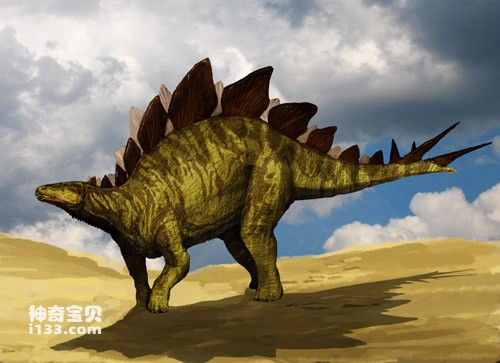Stegosaurus is a typical herbivorous dinosaur, with a total length of 8 to 9 meters, a height of 2.75 meters (excluding bone plates), and a weight of 3.1 tons. The original Latin meaning of Stegosaurus is "roofed lizard", a very vivid name. It has a very small head, 20 large bone plates with a height of 76 cm distributed on the spine, like roof tiles, and 4 spike-like ridges symmetrically growing at the end of the tail.
Stegosaurus walked on four legs and probably foraged for lower plants. Its head was often 1 meter above the ground because its hips were very high and its shoulders were quite low. In the Middle and Late Jurassic, water sources were usually covered with dense green carpets of dwarf ferns, and there were generally no tall trees in such places. The small gnawing and grinding teeth of Stegosaurus are very suitable for eating in such open places, and they look like a slow harvester.
The living environment of Stegosaurus is not safe. There are many masters of carnivorous dinosaurs. Allosaurus from North America and Airosaurus from Asia. These brutal killers who are interested in any kind of meat must have been paying attention to Stegosaurus all day long. However, Stegosaurus has developed a unique set of defensive weapons, namely the spike-like ridges on the tip of its tail. When attacked by a predator, Stegosaurus would turn its body to an appropriate position, pointing the bony plates sufficient to protect its entire body toward the attacker, and at the same time, use its long-spiked tail to whip the predator violently. These weapons and such defenses are not powerful enough to kill large predators, but they are often enough to provide a deterrent effect. Just imagine, who would step on four thumbtacks? Therefore, in order to avoid being injured, the predator would stop chasing the Stegosaurus and instead look for easier prey.
Observe Stegosaurus carefully. One of its most special features is its extremely small head. Imagine a huge creature weighing 1.8 to 2.5 tons. How can it be commanded by a brain smaller than a dog? Later, paleontologists discovered a small groove in the fossilized skeleton of Stegosaurus, a feature we have never seen in other dinosaurs. Therefore, the discoverer believed that there was a "second brain" of Stegosaurus in the groove, but now paleontologists generally believe that there should be a special nerve node in the groove, which is used to assist the brain in controlling the nerves of the hind limbs and tail. .
Another strange thing about dragons is the bone plates. There are two rows of bony plates in total. Unlike the horns of ceratopsians, the bony plates are made of bone rather than cuticle. There are different opinions on its purpose. The mainstream theory is that the bone plate is a defensive weapon. Non-mainstream theories include use in regulating body temperature. There are branch-like grooves on the surface of the bone plate, which may be choroidal grooves. There are many perforations inside the bone plate to form branch channels, so that the flow of blood can be controlled and the body temperature can be regulated. In addition, the pentagonal bone plates of Stegosaurus are staggered. This arrangement also helps the flow of air to take away the heat emitted from the bone plates. Therefore, Stegosaurus may have developed bone plates for two different purposes. Another theory is that the bony plates are covered in bright colors to attract the opposite sex. But there is a serious lack of evidence for this theory because fossils cannot preserve pigments.

Chinese name: Stegosaurus
Latin name: Stegosaurus
Era of survival: Late Jurassic
Fossil origin: Colorado, Utah, Wyoming, USA, Madagascar, Africa
Physical characteristics: 8 to 9 meters long
Diet: plants
Species: Stegosaurus
Definition: roofed lizard
animal tags: Stegosaurus
We created this article in conjunction with AI technology, then made sure it was fact-checked and edited by a Animals Top editor.